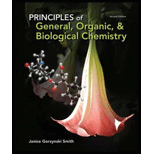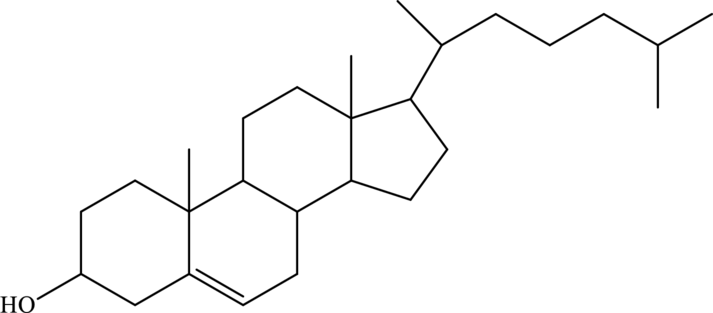
Principles of General, Organic, Biological Chemistry
2nd Edition
ISBN: 9780073511191
Author: Janice Gorzynski Smith Dr.
Publisher: McGraw-Hill Education
expand_more
expand_more
format_list_bulleted
Concept explainers
Question
Chapter 15, Problem 15.61AP
Interpretation Introduction
Interpretation:
Cholesterol is transported through bloodstream in lipoprotein has to be explained.
Concept Introduction:
Cholesterol belongs to the family of steroid with 3 six-membered rings and 1 five-membered ring. It is produced in liver and found in body tissues. The skeleton structure of cholesterol is as follows:

In lipoprotein, phospholipids and protein molecules with their polar part are attached on the surface. The nonpolar molecules are present inside the surface. Thus, nonpolar molecules become soluble in aqueous medium.
Expert Solution & Answer
Want to see the full answer?
Check out a sample textbook solution
Students have asked these similar questions
く
Complete the reaction in the drawing area below by adding the major products to the right-hand side.
If there won't be any products, because nothing will happen under these reaction conditions, check the box under the drawing area
instead.
Note: if the products contain one or more pairs of enantiomers, don't worry about drawing each enantiomer with dash and wedge
bonds. Just draw one molecule to represent each pair of enantiomers, using line bonds at the chiral center.
More...
No reaction.
Explanation
Check
O
+
G
1. Na O Me
Click and drag to start
drawing a structure.
2. H
+
2025 McGraw Hill LLC. All Rights Reserved. Terms of Use | Privacy Center | Accessibility
000
Ar
P
Draw a tetramer of this alternating copolymer.
H
I
T
H
HH
H
-H
C.
H-
Identify and select all structures below that represent a constitutional isomer(s) of the compound shown above.
H-
H
CIH
H
H
H
HHHH
H
H
0
·H
H–
冊
CH
CHI
HH C-
H-
H
H-
H
H
A.
H
H C
H
H-
-H
HH
H
B.
H-
-H
D.
H
H H
H
•
H
-H
E.
-H
H
H
HICH
T
HHH
F.
H-
Chapter 15 Solutions
Principles of General, Organic, Biological Chemistry
Ch. 15.1 - In which solvents or solutions will a lipid be...Ch. 15.2 - (a) Draw a skeletal structure for each fatty acid....Ch. 15.2 - Prob. 15.3PCh. 15.2 - Prob. 15.4PCh. 15.3 - Draw the structure of a wax formed from stearic...Ch. 15.3 - One component of jojoba oil is a wax formed from...Ch. 15.3 - What hydrolysis products are formed when cetyl...Ch. 15.4 - Draw the structure of a triacylglycerol that...Ch. 15.4 - Prob. 15.9PCh. 15.4 - Draw the structure of a triacylglycerol that fits...
Ch. 15.5 - Draw the products formed from hydrolysis of each...Ch. 15.5 - Prob. 15.12PCh. 15.6 - Draw the structure of two different cephalins...Ch. 15.6 - Classify each lipid as a triacylglycerol,...Ch. 15.7 - Why are phospholipids rather than triacylglycerols...Ch. 15.7 - Prob. 15.16PCh. 15.8 - Prob. 15.17PCh. 15.8 - Prob. 15.18PCh. 15.9 - Prob. 15.19PCh. 15.9 - Prob. 15.20PCh. 15.10 - Why is it much easier to overdose on a fat-soluble...Ch. 15.10 - Prob. 15.22PCh. 15 - Prob. 15.23UKCCh. 15 - Prob. 15.24UKCCh. 15 - Prob. 15.25UKCCh. 15 - What hydrolysis products are formed when the wax...Ch. 15 - Prob. 15.27UKCCh. 15 - Prob. 15.28UKCCh. 15 - Draw the products formed when the given...Ch. 15 - Prob. 15.30UKCCh. 15 - Prob. 15.31UKCCh. 15 - Prob. 15.32UKCCh. 15 - Prob. 15.33APCh. 15 - Label each compound as a hydrolyzable or...Ch. 15 - Prob. 15.35APCh. 15 - Prob. 15.36APCh. 15 - Prob. 15.37APCh. 15 - How does each of the following affect the melting...Ch. 15 - Rank the fatty acids in order of increasing...Ch. 15 - How would you expect the melting points of the...Ch. 15 - Prob. 15.41APCh. 15 - Why are soaps water soluble, but the fatty acids...Ch. 15 - Draw the structure of a wax formed from palmitic...Ch. 15 - Prob. 15.44APCh. 15 - Prob. 15.45APCh. 15 - Prob. 15.46APCh. 15 - Prob. 15.47APCh. 15 - What hydrolysis products are formed when each wax...Ch. 15 - Draw a triacylglycerol that fits each description:...Ch. 15 - Draw a triacylglycerol that fits each description:...Ch. 15 - Prob. 15.51APCh. 15 - Prob. 15.52APCh. 15 - Prob. 15.53APCh. 15 - Prob. 15.54APCh. 15 - Prob. 15.55APCh. 15 - Draw the products formed when the given...Ch. 15 - Prob. 15.57APCh. 15 - Prob. 15.58APCh. 15 - Prob. 15.59APCh. 15 - Prob. 15.60APCh. 15 - Prob. 15.61APCh. 15 - Why are LDLs soluble in the blood?Ch. 15 - Describe the role of HDLs and LDLs in cholesterol...Ch. 15 - Prob. 15.64APCh. 15 - Prob. 15.65APCh. 15 - Prob. 15.66APCh. 15 - Answer each question with regards to vitamins A...Ch. 15 - Answer each question in Problem 15.67 for vitamins...Ch. 15 - Prob. 15.69APCh. 15 - Prob. 15.70APCh. 15 - Prob. 15.71APCh. 15 - How are soaps and phosphoacylglycerols similar in...Ch. 15 - Some fish oils contain triacylglycerols formed...Ch. 15 - Some marine plankton contain triacylglycerols...Ch. 15 - Prob. 15.75APCh. 15 - Prob. 15.76APCh. 15 - Prob. 15.77APCh. 15 - Prob. 15.78APCh. 15 - Prob. 15.79CPCh. 15 - Prob. 15.80CP
Knowledge Booster
Learn more about
Need a deep-dive on the concept behind this application? Look no further. Learn more about this topic, chemistry and related others by exploring similar questions and additional content below.Similar questions
- Polylactic acid (shown below) is a biodegradable polymer used for food packaging. Identify the monomer(s) used in the production of this polymer using a condensation process.arrow_forwardDraw the product of the reaction shown below. Ignore small byproducts that would evaporate pleasearrow_forwardPoly(ethylene adipate) is a biodegradable polyester (shown below). Identify the type of polymerization process used in the production of this polymer.arrow_forward
- Polymers may be composed of thousands of monomers. draw two repeat units(dimer) of the polymer formed in this reaction. assume there are hydrogen atoms on the two ends of the dimer. ignore inorganic byproducts pleasearrow_forwardDraw the product of the reaction shown below. Use a dash or wedge bond to indicate stereochemistry of substituents on asymmetric centers, Ignore inorganic byproductsarrow_forwardDraw the product of this reaction please. Ignore inorganic byproductsarrow_forward
- One of the pi molecular orbitals of 1,3-butadiene (CH2=CHCH=CH2) is shown below. Please identify the number of nodal planes perpendicular to the bonding axisarrow_forwardDraw the monomers required to synthesize this condensation polymer please.arrow_forwardProvide the correct systematic name for the compound shown here. Please take into account the keyboard options belowarrow_forward
- curved arrows are used to illustrate the flow of electrons. using the provided starting and product structures, draw the curved electron-pushing arrows for the following reaction or mechanistic step(s)arrow_forwardIdentify the 'cartoon' drawing of the acceptor orbital in the first mechanistic step of an electrophilic addition reaction of butadiene with HBr. Pleasearrow_forwardH- H H H H H H Identify and select all structures below that represent a constitutional isomer(s) of the compound shown above. H- H H H A. H H H H-C CI H H D. H H H H H H C C -H H C C H H H H B. H CI H H- C C H H H H E. H CI H C.arrow_forward
arrow_back_ios
SEE MORE QUESTIONS
arrow_forward_ios
Recommended textbooks for you
 General, Organic, and Biological ChemistryChemistryISBN:9781285853918Author:H. Stephen StokerPublisher:Cengage Learning
General, Organic, and Biological ChemistryChemistryISBN:9781285853918Author:H. Stephen StokerPublisher:Cengage Learning Organic And Biological ChemistryChemistryISBN:9781305081079Author:STOKER, H. Stephen (howard Stephen)Publisher:Cengage Learning,
Organic And Biological ChemistryChemistryISBN:9781305081079Author:STOKER, H. Stephen (howard Stephen)Publisher:Cengage Learning, Chemistry for Today: General, Organic, and Bioche...ChemistryISBN:9781305960060Author:Spencer L. Seager, Michael R. Slabaugh, Maren S. HansenPublisher:Cengage Learning
Chemistry for Today: General, Organic, and Bioche...ChemistryISBN:9781305960060Author:Spencer L. Seager, Michael R. Slabaugh, Maren S. HansenPublisher:Cengage Learning Introduction to General, Organic and BiochemistryChemistryISBN:9781285869759Author:Frederick A. Bettelheim, William H. Brown, Mary K. Campbell, Shawn O. Farrell, Omar TorresPublisher:Cengage LearningChemistry: Matter and ChangeChemistryISBN:9780078746376Author:Dinah Zike, Laurel Dingrando, Nicholas Hainen, Cheryl WistromPublisher:Glencoe/McGraw-Hill School Pub Co
Introduction to General, Organic and BiochemistryChemistryISBN:9781285869759Author:Frederick A. Bettelheim, William H. Brown, Mary K. Campbell, Shawn O. Farrell, Omar TorresPublisher:Cengage LearningChemistry: Matter and ChangeChemistryISBN:9780078746376Author:Dinah Zike, Laurel Dingrando, Nicholas Hainen, Cheryl WistromPublisher:Glencoe/McGraw-Hill School Pub Co Introductory Chemistry: A FoundationChemistryISBN:9781337399425Author:Steven S. Zumdahl, Donald J. DeCostePublisher:Cengage Learning
Introductory Chemistry: A FoundationChemistryISBN:9781337399425Author:Steven S. Zumdahl, Donald J. DeCostePublisher:Cengage Learning

General, Organic, and Biological Chemistry
Chemistry
ISBN:9781285853918
Author:H. Stephen Stoker
Publisher:Cengage Learning

Organic And Biological Chemistry
Chemistry
ISBN:9781305081079
Author:STOKER, H. Stephen (howard Stephen)
Publisher:Cengage Learning,

Chemistry for Today: General, Organic, and Bioche...
Chemistry
ISBN:9781305960060
Author:Spencer L. Seager, Michael R. Slabaugh, Maren S. Hansen
Publisher:Cengage Learning

Introduction to General, Organic and Biochemistry
Chemistry
ISBN:9781285869759
Author:Frederick A. Bettelheim, William H. Brown, Mary K. Campbell, Shawn O. Farrell, Omar Torres
Publisher:Cengage Learning

Chemistry: Matter and Change
Chemistry
ISBN:9780078746376
Author:Dinah Zike, Laurel Dingrando, Nicholas Hainen, Cheryl Wistrom
Publisher:Glencoe/McGraw-Hill School Pub Co

Introductory Chemistry: A Foundation
Chemistry
ISBN:9781337399425
Author:Steven S. Zumdahl, Donald J. DeCoste
Publisher:Cengage Learning
Lipids - Fatty Acids, Triglycerides, Phospholipids, Terpenes, Waxes, Eicosanoids; Author: The Organic Chemistry Tutor;https://www.youtube.com/watch?v=7dmoH5dAvpY;License: Standard YouTube License, CC-BY